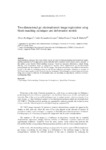Two-Dimensional Gel Electrophoresis Image Registration Using Block-Matching Techniques and Deformation Models

Ver/Abrir
Use este enlace para citar
http://hdl.handle.net/2183/18312
Excepto si se señala otra cosa, la licencia del ítem se describe como Atribución-NoComercial-SinDerivadas 3.0 España
Colecciones
- Investigación (FIC) [1682]
Metadatos
Mostrar el registro completo del ítemTítulo
Two-Dimensional Gel Electrophoresis Image Registration Using Block-Matching Techniques and Deformation ModelsFecha
2014-03-05Cita bibliográfica
Rodríguez A, Fernández-Lozano C, Dorado J, Rabuñal JR. Two-dimensional gel electrophoresis image registration using block-matching techniques and deformation models. Anal Biochem. 2014;454:53-59
Resumen
[Abstract] Block-matching techniques have been widely used in the task of estimating displacement in medical images, and they represent the best approach in scenes with deformable structures such as tissues, fluids, and gels. In this article, a new iterative block-matching technique—based on successive deformation, search, fitting, filtering, and interpolation stages—is proposed to measure elastic displacements in two-dimensional polyacrylamide gel electrophoresis (2D–PAGE) images. The proposed technique uses different deformation models in the task of correlating proteins in real 2D electrophoresis gel images, obtaining an accuracy of 96.6% and improving the results obtained with other techniques. This technique represents a general solution, being easy to adapt to different 2D deformable cases and providing an experimental reference for block-matching algorithms.
Palabras clave
2D gel images
Block-matching
Deformations
Electrophoresis
Optical flow
Proteomics
Block-matching
Deformations
Electrophoresis
Optical flow
Proteomics
Versión del editor
Derechos
Atribución-NoComercial-SinDerivadas 3.0 España
ISSN
0003-2697
1096-0309
1096-0309






